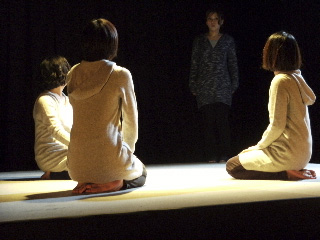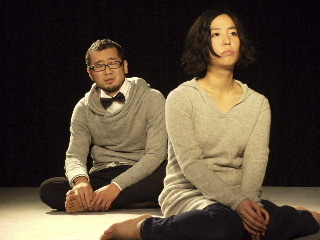

Con-Buri-Dan production
Muika
Data
:
Premiere: 2010
Length: 1h. 20min.
Acts, scenes: 1 act, 12 scenes
Cast: 5 (1 man, 4 women)
Muika (The 6th of August)

Born 1967 in Yonago city, Tottori Prefecture. Shin Hashiguchi is an actor and playwright. He became active in theater while a student Ritsumeikan University. In 1990 he participated in the founding of the Jiku Gekijo theater company. There, he performed in most of the company’s major productions as an actor. After the dissolution of Jiku Gekijo he continued acting with companies including Toenkai and Jabu Jabu Circuit. In 2007 he won the 9th Kansai Contemporary Theater Actor’s Award. As a playwright, his works have been performed by units from his years with Jiku Gekijo, and in 1997 he was awarded the Encouragement Prize of the Kyoto Theater Festival. In 2004, he formed the theater company Con-Buri-Dan. Until now, he has presented four plays, all of which he has written and directed.


Con-Buri-Dan production
Muika
Data
:
Premiere: 2010
Length: 1h. 20min.
Acts, scenes: 1 act, 12 scenes
Cast: 5 (1 man, 4 women)
At first there is an announcement: “We want to thank you for being here today. Please turn off your mobile phones.” Normally an announcement would stop there, but it doesn’t in this case. It goes on to talk about the functions of portable cameras and how in the past the problem used to be with beepers. Gradually the subject changes and the speaker is talking about how they first got into theater in college.
Eventually the subject moves on to the speaker’s hometown, Hiroshima. Then he proceeds to describe the scenery going by outside the window, as if he is actually riding on a tram through the streets of Hiroshima.
Finally one of the stage staff members objects that the announcement is going on too long. At which point the speaker stops and the play begins.
The stage is square and raised like a Noh stage. There are no set fixtures or props.
Woman A is lying down on the floor. The stage can be seen as a hospital room. A group of four men and women enter as if they have come to visit the sick woman, but instead they play at making stories, saying, “Pretend this place is a movie theater …” or “in a train …” or “a museum …” or “a hospital …”
At one point someone says, “If we use our imagination we can bring about a transformation. That is the rule of this world.”
In the meantime, Woman A has gotten up and joined in the conversation, but she seems hesitant and appears to be buffeted but the goings-on.
The conversations about “Suppose things were like such-and-such …” or “What if things were like such-and-such?” and eventually comment emerges that, no matter how things might seem to change there is always war in the world. From petty quarrels between friends to war or conflicts between countries or ethic groups, there is always bloodshed in the world. And wherever there is conflict there is always a “just cause” to justify it. That has been true with every war or conflict of act of terrorism since the atomic bomb was dropped on Hiroshima.
We live in a world where there is always war going on somewhere.
The “Pretend this place is …” game gives way to a setting before dawn on the morning of August 6th in 1945, the year Japan’s Pacific War ended.
Woman A has reached the conclusion that she doesn’t understand the world. She suspects that everything is simply her own delusion.
Woman A suddenly remembers that in this place she is a young woman named Sachiko, and that all her family loves her. Then she recalls that on that fateful day [August 6th] she was the only one of her family to survive. Since that time she has been living with the dead.
The scene is in a hospital. As at the beginning, Woman A is lying down. The people around her are asking, “Grandma, are you feeling alright?” “Are you OK?”
Was everything that has happened to this point simply images in the mind of the old woman A? No one knows…
The people around her could be her children and grandchildren but, then again, they could be the dead members of her family.
The dead speak, saying, “One can give up being alive. But if you live you can imagine, and if you imagine, the world can change.” That is the rule of this world.
Woman A returns to that fateful morning. She makes the decision to live in this world.
Soft rays of morning light envelope all of the characters of the play, and the world.
Again this year, there will be a 6th of August.
Related Tags